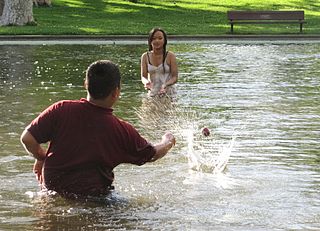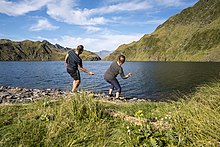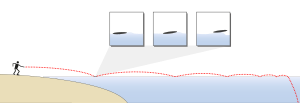
Curling is a sport in which players slide stones on a sheet of ice toward a target area which is segmented into four concentric circles. It is related to bowls, boules, and shuffleboard. Two teams, each with four players, take turns sliding heavy, polished granite stones, also called rocks, across the ice curling sheet toward the house, a circular target marked on the ice. Each team has eight stones, with each player throwing two. The purpose is to accumulate the highest score for a game; points are scored for the stones resting closest to the centre of the house at the conclusion of each end, which is completed when both teams have thrown all of their stones once. A game usually consists of eight or ten ends.

Snowmobile skipping, snowmobile watercross, snowmobile skimming, water skipping or puddle jumping is a sport and/or exhibition where snowmobile racers hydroplane their sleds across lakes or rivers.

A ricochet is a rebound, bounce, or skip off a surface, particularly in the case of a projectile. Most ricochets are caused by accident and while the force of the deflection decelerates the projectile, it can still be energetic and almost as dangerous as before the deflection. The possibility of ricochet is one of the reasons for the common firearms safety rule "Never shoot a bullet at a flat, hard surface." Ricochets can occur with any caliber, but short or round ricocheting bullets may not produce the audible whine caused by tumbling irregular shapes. Ricochets are a hazard of shooting because, for as long as they retain sufficient velocity, ricocheting bullets or bullet fragments may cause collateral damage to animals, objects, or even the person who fired the shot.

An antibubble is a droplet of liquid surrounded by a thin film of gas, as opposed to a gas bubble, which is a sphere of gas surrounded by a liquid. Antibubbles are formed when liquid drops or flows turbulently into the same or another liquid. They can either skim across the surface of a liquid such as water, in which case they are also called water globules, or they can be completely submerged into the liquid to which they are directed.
Easdale is one of the Slate Islands, in the Firth of Lorn, Scotland. Once the centre of the Scottish slate industry, there has been some recent island regeneration by the owners. This is the smallest of the Inner Hebrides' inhabited islands and is "home to traditional white-washed cottages, a small pub and disused slate quarries". One of the latter, filled with water, is used for swimming.

A trampoline is a device consisting of a piece of taut, strong fabric stretched between a steel frame often using many coiled springs. People bounce on trampolines for recreational and competitive purposes.

The Flying Circus of Physics by Jearl Walker, is a book that poses 740 questions concerned with everyday physics. The emphasis is strongly on phenomena that might be encountered in one's daily life. The questions are interspersed with 38 "short stories" about related material.

A physics engine is computer software that provides an approximate simulation of certain physical systems, such as rigid body dynamics, soft body dynamics, and fluid dynamics, of use in the domains of computer graphics, video games and film (CGI). Their main uses are in video games, in which case the simulations are in real-time. The term is sometimes used more generally to describe any software system for simulating physical phenomena, such as high-performance scientific simulation.
This is a glossary of terms in curling.

In angling, casting is the act of the angler throwing the bait and hook as well as other attached terminal tackles out over the water, typically by slinging a fishing line manipulated by a long, elastic fishing rod. The term itself may also be used for setting out a net when artisanal fishing.
The following terms are used in water polo. Rules below reflect the latest FINA Water Polo Rules.

Barbora Špotáková is a former Czech track and field athlete who competed in the javelin throw. She is a two-time Olympic Champion and three-time World Champion, as well as the current world record holder with a throw of 72.28 m.

The 1983 NCAA Division I women's basketball tournament began on March 18 and concluded on April 3 with USC winning the title. The tournament consisted of 36 teams. The Final Four was held in Norfolk, Virginia and consisted of USC, Louisiana Tech, Old Dominion, and Georgia. USC's Cheryl Miller was named the Most Outstanding Player of the tournament.

Waboba is an international outdoor toy and sporting goods brand headquartered in Stockholm, Sweden with offices in Atlanta, Georgia and Guangzhou, China. Waboba is most known for its invention of balls that bounce on water, the high bouncing Moon ball, and the Wingman silicone flying disc. The company specializes in beach and backyard toys and games. The slogan used in advertising is Keep Life Fun. The name Waboba is a registered trademark and many of its products are internationally patented.

The 2001 Unforgiven was the fourth annual Unforgiven professional wrestling pay-per-view (PPV) event produced by the World Wrestling Federation. It took place on September 23, 2001, at the Mellon Arena in Pittsburgh, Pennsylvania. It was the final Unforgiven event held under the WWF name as the promotion was renamed to World Wrestling Entertainment (WWE) in May 2002. It was also the last Unforgiven held before the introduction of the brand extension in March 2002.

Waterballs are water toys that are played on the water surface with players interacting with the water toy and the water in any number of play patterns. Generally players throw waterballs at varying speeds across the water and air at varying angles to get the desired skip pattern. Play is generally between players and play patterns can involve a variety of apparatus and equipment, such as special pools with goals and watercourts.

An eight-ender is a perfect score within a single end of curling, with one team scoring the maximum possible value of eight points—one for each rock the team put in play during the end.

The physics of a bouncing ball concerns the physical behaviour of bouncing balls, particularly its motion before, during, and after impact against the surface of another body. Several aspects of a bouncing ball's behaviour serve as an introduction to mechanics in high school or undergraduate level physics courses. However, the exact modelling of the behaviour is complex and of interest in sports engineering.

Kim Kyeong-ae, nicknamed "Steak" is a South Korean curler. She currently plays third on Team Kim Eun-jung. The Kim team represented South Korea at the 2018 Winter Olympics, where they won a silver medal.
Kurt Steiner is an American man who holds the Guinness World Record for stone skipping, scoring 88 bounces of the stone in 2013. Known as "The Mountain Man", Steiner resides in rural Cameron County, Pennsylvania.


















